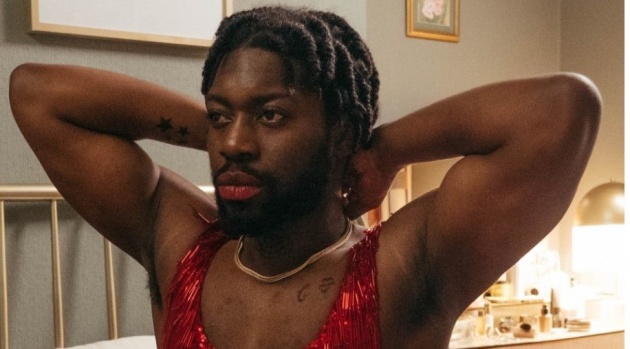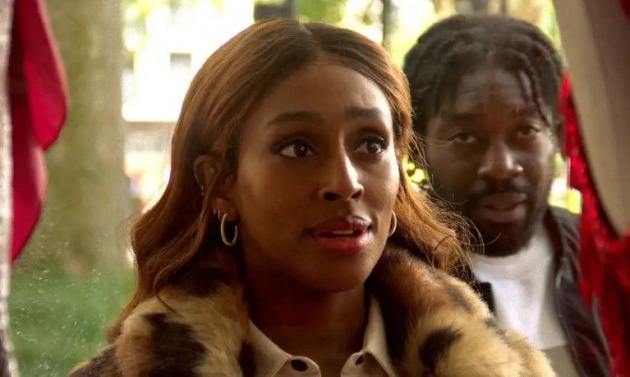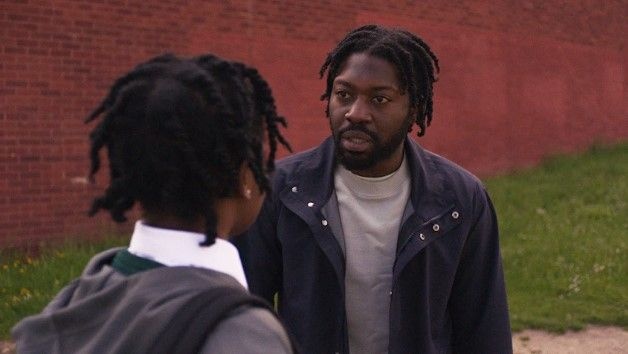
Pictured: Travis (Natey Jones) says yes to the dress in a scene from the British family drama, 'Pretty Red Dress', written and directed by Dionne Edwards. Still courtesy of BFI Distribution.
In South London, some people collide with you on purpose, shoulder against shoulder, and hiss, ‘what’s your problem?’ If you are sensible, you will pick up the pace and not prolong the encounter. If you are insensible, that’s because you answered back and ended up with a fist in the face. Long hot summers bring out a desire for distraction, a need to win. You can’t beat the sun; you can clobber a stranger.
Writer-director Dionne Edwards makes her feature debut with the British drama, Pretty Red Dress. It is a tale of a dysfunctional South London family, the very sort who might ask, ‘what’s your problem?’ It is a film about being uncomfortable in your skin but not knowing why. Instead the characters reach out for alternatives, finding some comfort – or release – in the titular garment.
The dress means different things to Candice (Alexandra Burke), Travis (Natey Jones) and their teenage daughter Kenisha (Temilola Olatunbosun). For part-time singer, full-time shop worker Candice, it is something she cannot afford but very much wants to wear for an audition to play Tina Turner in a potential West End musical. For Travis, fresh out of prison and reluctantly in the employ of his younger brother, Clive (Rolan Bell), who runs a restaurant and makes him feel perennially grateful, the dress is a gift for the mother of his child who stood by him, but it is also something irresistible. For fourteen-year-old Kenisha, it is a source of embarrassment. My mum wants to be Tina Turner – whatever. My dad wants to wear a dress – that’s messed up.
Edwards puts these three characters in perpetual conflict. Kenisha answers back her mother and won’t go shopping with her. She is feisty. Candice doesn’t understand why Travis puts on her dress. Is he gay? Travis involves Kenisha in his deception after ripping the dress, but he also senses the teenager’s own crisis of confidence. At her lowest ebb, Candice takes a picture off the wall.
Edwards workshopped the script at the Sundance Institute. The film bears the scars of too much feedback. There is a point at which a screenwriter can’t solve the problem they have created and turns to others, in this case to answer the question, ‘what does wearing the dress tell Travis about himself?’ In the end, Edwards leaves the audience to draw their own conclusion. Kenisha is equally afflicted by her own teenage pains. She says she is attracted to a boy but cannot talk to him. Eager to assist, Candice gives her strong advice, fuelled by a desire to be genuinely helpful. When she and Travis see Kenisha with a girl, they reach the wrong conclusion.

Pictured: Candice (Alexandra Burke) in a scene from the South London family drama, 'Pretty Red Dress', written and directed by Dionne Edwards. Still courtesy of BFI Distribution (UK)
The most interesting aspect of the film is the performance coaxed by Edwards from the untrained Alexandra Burke. Burke is a singer who found fame on a television talent show who has turned to acting midway through her career. Film acting requires a different sort of performance – stillness, the adoption of a persona. Burke wobbles between playing a less successful version of herself and a South London mother facing some trying times. When she performs Tina Turner standards (‘River Deep, Mountain High’), her performance is neither polished nor confident; good enough, but not transcendent. Contrast this with the naturalism of her acting in a scene in which the police visit to investigate the noise coming from Candice’s flat. Burke channels the righteous indignation of every black British woman whose abode has been entered by uninvited police officers. She is not playing a woman who believes they could be a West End star and therefore has to manage her image. Rather Burke is angry, unbridled, completely in the moment, explosive.
Normally in a film about a family, you worry whether the child actors are being exploited by the director. Here, I feared for Burke. I never felt she was in control, rather prodded to behave in different ways in different scenes. Actors can impose a unity on their performance through reserve – knowing when not to let their own personality appear. I didn’t feel that Burke exhibited this control, in spite of the rehearsal period she and the cast enjoyed before filming. In one scene, Edwards frames Burke so that her head is out of shot and we look at her torso – her body is on display. The scene is a sexualised one – Travis pulls Candice towards her. There is very little difference between the way Edwards frames her and how a male director might do so for the purpose of titillation.
The shaping of Burke’s performance is off from the opening credit sequence, in which we see Candice sing. The cutting is frantic – it is almost a parody of a musical. On the one hand, it suggests slickness and polish. However, Candice has not achieved any sort of fame. The camerawork and editing exaggerate her accomplishment. Candice is a talented amateur waiting for a big break. She is decidedly not a star slumming in South London, something Burke appears to be. Edwards doesn’t flatter her lead performer.
Nevertheless, discomfort with a persona is the film’s subject. In a strange, perhaps unintended way, Burke’s performance is exactly right. Natey Jones’ performance is more actorly. We don’t expect men to explain themselves – as Travis, Jones doesn’t try. Rather we see him in the grip of an obsession, one that ends in a curse word as Travis rips Candice’s dress after trying it on one too many times.
Father and daughter have one thing in common – they don’t want to be moulded. Kenisha’s anger at her mother seems unjustified, ungrateful. For the time Travis was in prison, Kenisha was raised by a single parent. However, she utterly does not identify with her mother. This is perhaps a teenage thing, but Kenisha’s antipathy is next level. She doesn’t fully engage with her parents, instead being self-absorbed. This disengagement means that she wants very little from them – and takes what she gets for granted. She also sees something in her mother that she doesn’t want to emulate – the sense of needing some sort of fame. It is as if Kenisha has concluded that Candice will fail and so is completely uninvested in her mother’s sideline. At what point had she arrived at this conclusion? Possibly when her father went to prison.
After ripping Candice’s red dress, Travis asks Kenisha to take the blame. She does so, much to Candice’s surprise – prior to this, Kenisha appeared to have no interest in feminine clothing. This proves to be a moment of relief. Candice wants Kenisha to enjoy fashion, if only to help build her self-confidence.
Travis’ obsession with Candice’s dress leads to him putting on her pantyhose and it being visible at work. Clive berates him for it, prompting Travis to break a plate. Clive’s smarmy sense of self-importance irritates him. Clive is the sort of second son eager to demonstrate his value, even though it is finally built on the efforts of others. He is a well-defined character, showing off how he intends to take his mother back to Jamaica. ‘Who did that first?’ Travis asks him.
There is a curious scene in which Travis tries on another of Candice’s dresses and steps out onto the landing outside of her flat. We almost expect the moment to be a prelude for jeopardy, but Edwards doesn’t show the door slamming behind him and Travis being forced to interact with others whilst in women’s clothing. Instead, the scene shows him testing the limits of his redefined identity.

Pictured: Attempting to be a dad, Travis (Natey Jones) speaks to Kenisha (Temilola Olatunbosun) in a scene from the South London family drama, 'Pretty Red Dress', written and directed by Dionne Edwards and produced by Georgia Goggin. Still courtesy of BFI Distribution (UK)
There is also a sense of masochism in Travis’ obsession. Towards the end of the film, having been kicked out by Candice after an incident at Clive’s birthday party, he walks past some boys and then puts on the repaired dress in front of them. He then invites their attention before getting into a fight. It is as if he wants to test his tolerance for the worst kind of censure – one that results in violence – to find out if he can cope. The fight results in this catharsis. The camera later follows Travis as he walks down the street in women’s clothing, offset by his beard. He isn’t trying to be feminine, rather asexual.
Candice has a couple of callbacks, including a scene where she acts as Tina opposite a white Ike Turner stand-in. The film offers a commentary that theatre producers don’t always help actors get into character. Where is the racial verisimilitude? Edwards shows us another actress belting out a Tina Turner song with more force than Candice can muster, as if to justify why Candice was finally rejected. Meanwhile, Kenisha has a confidence betrayed by a schoolfriend and demonstrates how much like her father she actually is.
Pretty Red Dress has an optimistic ending. Ultimately, Travis’ physical appearance isn’t provocative of itself; it is only his desire for confrontation that attracted violence. Travis enjoys his self-expression through women’s clothing, but he isn’t given a label (gay, transvestite, gender fluid). The film asks us not to draw conclusions and certainly not to offer unwanted commentary by remarking, ‘what’s his problem?’
Reviewed at Ritzy (Picturehouse) Cinema, Screen One, Brixton, South London, Thursday 15 June 2023, 18:30 screening



